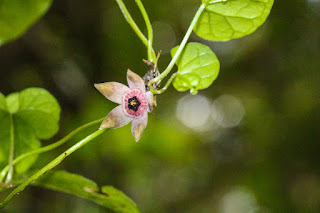Our scheduled CREW visit to Ntsikeni Nature Reserve was cancelled due to the lack of rain. However, we were asked to assist a tour group by providing local knowledge of the plant species at Ntsikeni and used this as an opportunity to visit Garden Castle Nature Reserve as well.
The internal road at Ntsikeni is now much improved making access to this delightful reserve far easier. We met the tour group at the entrance to Ntsikeni and within a short while we were exploring the grassland. We found the orchids Disa stachyoides, Habenaria laevigata and Orthochilus foliosus and close by an Aspidonepsis flava.
 |
| Aspidonepsis flava |
At the next stop we found some beautiful heads of Asclepias macropus close to the side of the road.
 |
| Asclepias macropus |
We decided to stop for lunch at the first river crossing despite the noise of the construction team working on the causeway. After a brief lunch the group were soon admiring the colony of endangered Disa scullyi in the wetland and the nearby Habanaria schimperiana.
 |
| Disa scullyi |
Our last stop was at a ridge not far from the Lodge. Walking northward along the ridge we were able to show the group a yet-to-be-described Xysmalobium species, Kniphofia laxiflora, Disa cornuta and a good colony of Satyrium hallackii.
We left the tour group shortly after this and headed for some friends who live near Underberg. Early the next morning we drove to the Garden Castle Nature Reserve and explored the grassland along the river. Here we found two species of orchid (both rare) that we had not previously encountered, Disa tysonii and Satyrium microrrhynchum, as well as many of the more common Bolusiana tysonii.
 |
| Bolusiana tysonii |
Near the reserve we were happy to find a small group of Nerine appendiculata in flower. As there is a significant disjunct in the flowering time of this population and that of the same species at Ngele (May), it will be interesting to compare the DNA of these two populations.
Participants: Graham G, Kate G.





















































